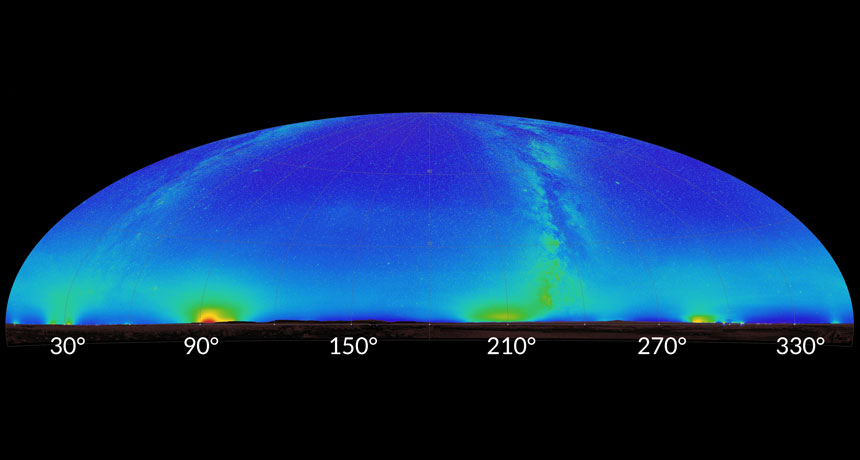Pollution from new technologies threatens astronomy
Satellites, LEDs and Wi-Fi may make it harder to ‘see’ the stars

This panoramic view of the night sky was taken in Arizona. It shows how light from Winslow, Phoenix and Flagstaff (red and green spots, left to right, starting at 90°) makes it harder to see the stars.
Dan Duriscoe/National Park Service
Share this:
- Share via email (Opens in new window) Email
- Click to share on Facebook (Opens in new window) Facebook
- Click to share on X (Opens in new window) X
- Click to share on Pinterest (Opens in new window) Pinterest
- Click to share on Reddit (Opens in new window) Reddit
- Share to Google Classroom (Opens in new window) Google Classroom
- Click to print (Opens in new window) Print
By Dan Garisto
OXON HILL, Md. — Astronomers can peer more deeply into the cosmos than ever before. The key is new technology. But new technology can have a dark side. It can create pollution that interferes with astronomers’ work.
Space debris, light pollution and radio waves are the most worrisome. And the situation is getting worse. These types of pollution could prevent astronomers from getting a clear look at the night sky. This warning came from speakers at the annual meeting of the American Astronomical Society on January 9.
Just six decades have passed since the former Soviet Union launched Sputnik, the first artificial satellite. Back then, there was no terrestrial debris around Earth. But conditions have changed. Today, U.S. government scientists track nearly 18,000 objects orbiting Earth. Most are considered space “junk.” These objects range in size from centimeter-long chunks of metal or other spacecraft debris to bus-sized satellites.
And here’s the problem. All of this junk can damage existing space telescopes. What’s more, many also can reflect light, which could potentially confuse observers using ground-based telescopes. From Earth, a glint of light could be a distant star — or just a hunk of metallic junk.
“The worst is yet to come,” warns Patrick Seitzer. He is an astronomer at the University of Michigan in Ann Arbor. “We’re going to double our catalog [of debris] over the next 20 years.” There’s an aerospace company called Boeing, for example, that wants to launch a global network of nearly 3,000 satellites. And collisions between any two of them could cause problems. Any smashup can release thousands of new pieces of debris.
Polluting with light
Down on Earth, light pollution is a well-known problem. Artificial lights can outshine the light of stars. And a shift by many nations to illuminating the environment with light-emitting diodes, or LEDs, isn’t helping.
In 2010, LEDs constituted less than 1 percent of the American lighting market. Today, they account for about half. And their share is expected to grow.
LEDs do have environmental and economic benefits. They are long-lived and energy efficient. But they emit a broad spectrum of light, meaning wavelengths that include many colors. These include blue-rich light, which is especially bad for astronomy. Blue light scatters more easily than longer wavelengths, such as yellow light. That scattering worsens sky glow, a sort of haze of light created as the light reflects off of particles in the air above big cities. Sky glow makes it hard to see the stars.
Radio waves, another source of energy, also pose a problem for star gazers. Astronomers search space for radio waves generated by stars and galaxies. But Earth-based sources of this energy can be confused for those signals. Those terrestrial radio sources can include Wi-Fi and even driverless cars. For instance, the radar on driverless cars could affect radio astronomy operations up to 100 kilometers (62 miles) away, said Harvey Liszt. He is a radio astronomer at the National Radio Astronomy Observatory, based in Charlottesville, Va.
Saving the stars
There is no doubt that technology is affecting the visibility of skies for astronomers across the planet. That’s why the late astronomer Jean Heidmann proposed a radical idea. He suggested putting a telescope on the moon. He’d site it on the far side, away from Earth. There, it would be safe from space debris, light and radio pollution, he noted.
Another, less extreme idea: Impose strict government regulation on radio frequencies. Astronomers may need to expand and secure what are known as “radio quiet” zones. A notable one covers half of West Virginia. It was developed to surround the extremely sensitive Green Bank Observatory. It’s home to the world’s biggest fully steerable radio telescope. In this almost 34,000 square-kilometer (13,000 square-mile) region of radio silence, there is no cell-phone service and almost no radio stations. People here communicate with land-line phones or call from the road at phone booths.
Without a similar effort to safeguard the radio airways, “radio astronomers would lose the ability to observe,” says Liszt. Such action might be the only way, he argues, to preserve a future for Earth-based radio astronomy.
As for artificial light, having none would be best — at least to many astronomers. But most realize that’s almost a futile fight. Still, there are ways to cope. Flagstaff, Ariz., is adopting LED lights. But this city is using what are known as narrow-band amber LEDs. They resemble the yellow, low-pressure sodium lights that many cities have used in the past, and that astronomers prefer. One reason: They limit sky glow.
“Dark skies have become part of the culture here,” said Jeff Hall. He is an astronomer and director of the Lowell Observatory in Flagstaff. He describes it as “a community value. We even have a company called Dark Sky Brewing.”
Such down-to-Earth solutions to pollution may be astronomers’ only hope.







